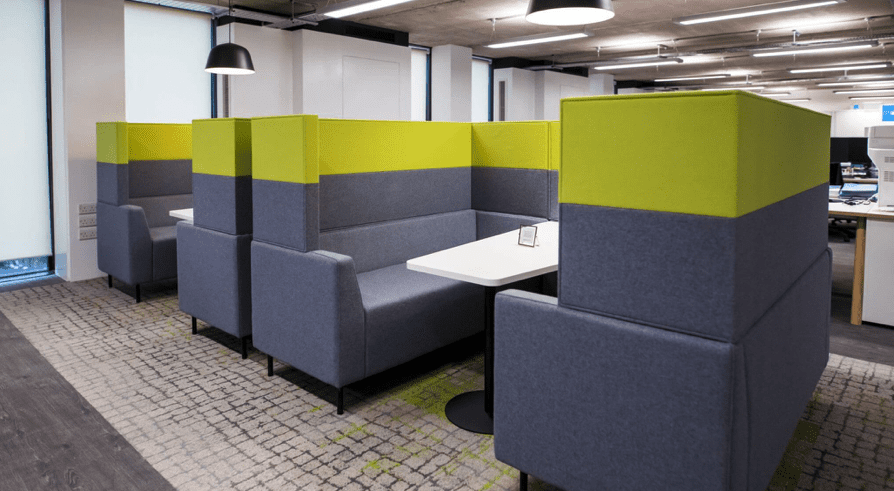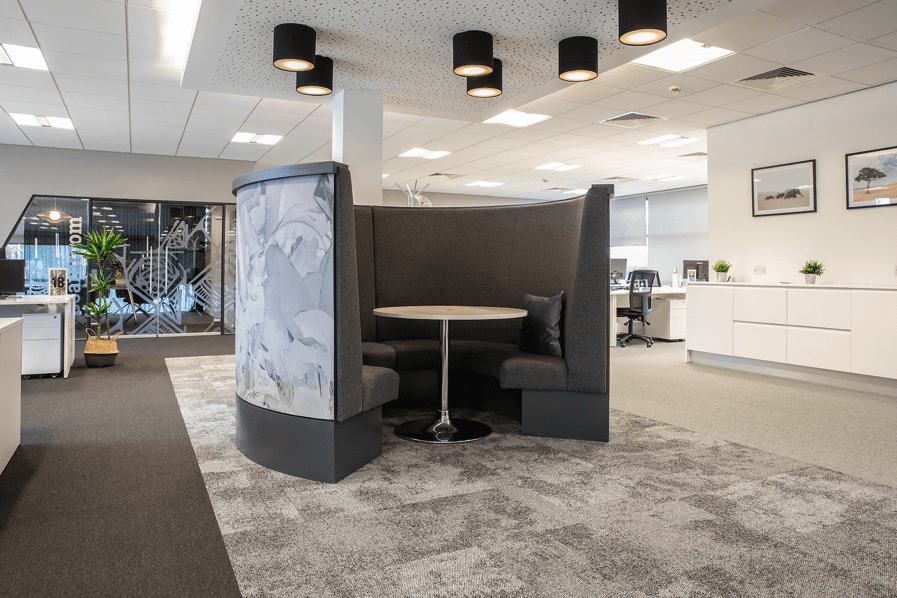Your Guide to Acoustics In Office Interior Design ... and the difference good acoustics can make
We’ve all been there; you’re in the zone, getting some of your very best work done and then there’s one colleague chatting away on a loud phone call, or playing their music at a volume that’s not exactly conducive to productivity. Or perhaps it’s the sound of the telephone constantly ringing or other noisy machinery that’s distracting you. In an office setting, there can be many possible distractions.
Before you know it, your productive streak has been replaced by annoyance, you’ve lost your train of thought and eventually, just go make a coffee instead. This is precisely why a focus on Acoustics is so important when it comes to interior design in the workplace.

Yes, unwanted noise can be a total productivity killer, adding to stress levels and breaking concentration right in the middle of a crucial task, but it’s nothing that can’t be solved.
What can you do about noise affecting productivity?
Despite the emphasis on igniting creativity and improving employee wellbeing, acoustics (generally speaking) appear to have been overlooked in the design process of many modern offices, in favour of featuring highly reverberant surfaces, such as hard floors, ceilings, and desks, meaning the noisy distractions become amplified.
It’s not rocket science though; keeping your team happy, motivated and focussed is crucial if you want to get the best work out of them, and noise is the most frequent complaint amongst office workers.
To create a work-friendly environment, noise should be absorbed instead of being reflected.
Open-plan offices and acoustics
Office design is constantly evolving and the trend is definitely for open plan spaces, enabling light to flow, employees to socialise and collaborate, and for general stress levels to drop. However, the open-plan office is not so good for noise and disruption, in fact, it can be terrible for it, whether you’re operating in a small business or large organisation.
Providing staff with only open-plan spaces to work without due attention to acoustics may well result in them choosing to work remotely if they know they can control the noise levels at home or elsewhere.
Luckily we’ve got some top tips and clever acoustic solutions to save your office from noise pollution and keep that efficiency high.

Seating with sound buffering panels in the Search Consultancy offices in Manchester.
The solutions to your open-plan workspace disruption:
Office layouts
The antidote to open plan office spaces is to offer ways for employees to create flexible, private spaces on a more ad hoc basis, such as incorporating dividing elements which provide privacy and encourage concentration. These should be easy-to-transport and durable to allow for plenty of use and movement.
These sound-buffering elements also allow you to play with the layout of the room, creating different arrangements depending on your needs. Any stationary pods should ideally be located fairly centrally to encourage use, whereas board rooms could be placed further away to reduce the disruption to the rest of the office.
You could also make sure that team members who do more solo or analytical work be positioned away from sales teams or those who work on the phone a lot.
Office behaviours
You could also try encouraging workers to speak in lower voices in the communal areas and suggest that long phone calls are taken in a different room. Employees should then ensure doors are closed when these meeting rooms or pods are in use. It also seems fair that speaker phones be prohibited whilst working at desks in open plan areas.
Acoustic treatments for the office
There are a number of ways you can attempt to soundproof the internal structure of the workplace.
As mentioned above, free-standing screens can be a great option that requires little to no laborious installation, but there are also a number of materials on the market that can be used in the fixed decor, such as cork panels for flooring or walls, that will absorb sound effectively. Perforated ceilings with sound absorptive insulation or panels can be fixed or hung, either horizontally or vertically as buffers.
Ceiling-based solutions are especially great for large spaces. Treatments that hang from above reduce reverberation by redirecting sound waves in a way that means no echo is produced. Done right, this also provides a stylish new look to your office space.
Adding ambient noise
Adding MORE noise into the mix might seem counterproductive but actually playing ambient sounds can help mask the more annoying and distracting ones. Research suggests that noise itself isn’t distracting, but rather it is ‘unwanted noise’ that is the real productivity killer affecting your workforce.
Playing low-level, ambient sound (such as music, ideally via playlist from proper speakers) makes sudden noises less noticeable and other people’s conversations much easier to ignore.

Centrally located fabric seating with high backs to muffle noise and contain conversation in the LeoVegas offices in Newcastle.
Plants to buffer office noise
Plants do a nice job at absorbing the sounds of the office, while adding to the look and feel of the space, and it’s a fairly simple and cheap way to do it so you may want to consider bringing the outdoors in to help with poor office acoustics.
We’ve gone into more depth on biophilic design (as it’s called by those in the know) in a previous post.
Furniture solutions
Thanks to the trend for open-plan offices, manufacturers of office furniture have thrown themselves into designing elements that limit and absorb excessive noise, creating pleasant workspaces that improve performance.
There are so many options on the market, from privacy screens, telephone booths, meeting pods and breakout furniture with high backs or panels designed to muffle the unwanted sound.
We’ve got our furniture specialist, Danielle’s take on five of the best products available at the moment.
1. These clever BuzziPlanters from BuzziSpace absorb sounds while allowing you to add your own choice of lovely plants to bring the outside in.
2. The Acoustic Escape Pods and Acoustic Meeting Pods by The Meeting Pod Company are specially treated, circular meeting and collaboration pods, featuring acoustic internal foam and even double glazed glass doors on the Meeting Pods.
3. This Flex Acoustic Barrier by Steelcase is on wheels, allowing it to be easily moved. Steelcase whiteboards can be affixed too, creating a collaboration space while absorbing the sound of the collaboration from other areas.
4. Baudot Zero by Allermuir is a different style of freestanding acoustic item. We like it because it looks a lot more playful than usual freestanding screens and doesn’t take up a lot of space.
5. BuzziFalls Standing from BuzziSpace have several patterns you can choose from. They can be assembled as either single units or multiple units together to make a larger Z shape screen, as shown below.
So, have we got you thinking about your own office acoustics?
Yes? Great! Your employees will certainly thank you for it!
As workplaces are gradually getting busier again post-Covid, addressing your workplace acoustics is basically investing in the wellbeing and productivity of your employees, which will, in turn, impact the success and growth of your business.
Get in touch with our savvy team to benefit from their experience and knowledge. Our effective solutions will be tailored to your specific requirements, while always remaining attractive and stylish. Let’s start creating a better working environment for you and your team.
